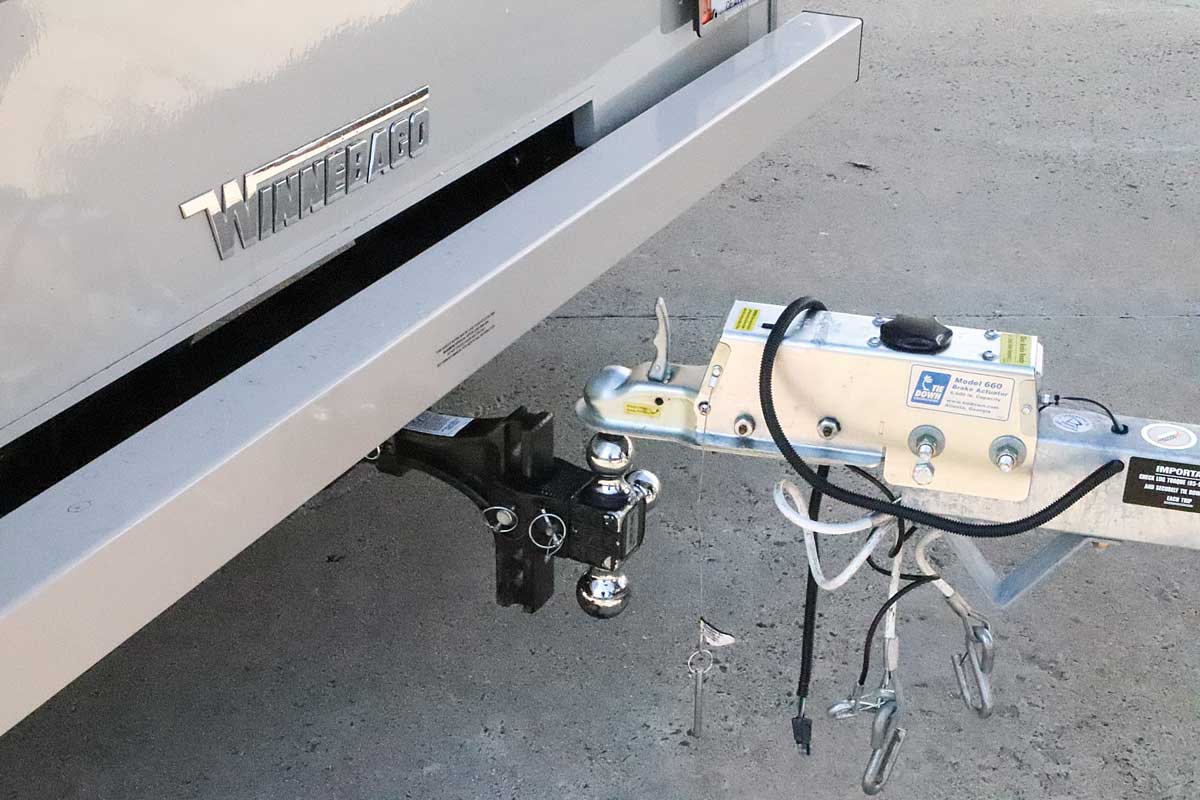Here’s everything you need to know — from towing to launching — in order to bring a good-sized bass or powerboat along on your travels.
Weight a Minute
The very first consideration is whether or not your motorhome can tow a boat. Some motorhomes, specifically some Class B’s and Class C’s, can’t tow anything, which is commonly the case when a Class C chassis is stretched for a longer motorhome. In the case of some Class B’s, there’s too much equipment under the van to allow mounting of a receiver. It’s vital to determine any motorhome’s tow rating. The manufacturer may have provided a gross trailer weight (GTW) rating, which is the maximum weight that can be towed by the motorhome. A basic GTW of a new motorhome can be calculated by subtracting the actual (curb) weight from the gross combined weight rating (GCWR), but an accurate number can’t be established until the motorhome is loaded for a trip and weighed.
Next, verify the motorhome has the proper hitch receiver and trailer brake control, if required, in place. Do not depend on the rating label on the hitch receiver to determine the GTW capability of the motorhome. Occasionally, a receiver will have a higher rating than the motorhome can handle.
Most boat trailers have hydraulic surge brakes, in which case you don’t need a brake control, just a flat four-pin-type trailer lighting connector for the running- and brakelights. Additionally, you’ll need a ball mount with the right size ball, possibly with a drop to keep the trailer level, and a wiring adaptor, if required.
Hitch weight also comes into play. Some trailers for larger boats may have a higher hitch weight than the motorhome can handle, either from the standpoint of the gross vehicle weight rating (GVWR) or the rating of the hitch.
Ready for Launch
Launching a boat with a motorhome is not impossible, but it must be done with great care. Backing a motorhome down a ramp, especially a steep one, puts a lot of extra load on the chassis and brakes, and unless your RV is an amphibious Terra Wind, it won’t float well as a boat. Also, keep in mind that most motorhomes are two-wheel drive, which could make traction on a slick boat ramp an issue.
There are a few things you can do to make launching a boat from your motorhome a better, safer process. First, check the ramp and make sure it can hold the motorhome from both a weight and a width standpoint. Smaller, lighter rigs probably won’t present a problem, but if you’re using a larger coach, make sure the ramp can hold the load. If folks are launching larger vessels from the ramp, you’re probably OK.
Second, check and double-check the hitch, wiring connection and lights, and make sure that the boat is adequately secured to the trailer.
Third, always have at least one spotter out back watching the boat and the motorhome. Plenty of people launch boats by themselves, but using a motorhome to launch adds complexity — and even more blind spots — even with a camera system. Using a pair of two-way radios can help ease the backing process and eliminate much of the potential drama inherent in the process.

When stopping the boat trailer and motorhome on the ramp, chock the motorhome and/or trailer wheels with large wheel chocks like the rubber one pictured here. The spotter can be in charge of this step. Place the chocks under the trailer tires if a stop is needed, then pull them out and wait until the boat is in the water, at which point they can be placed in back of the motorhome wheels. Always set the parking brake whenever stopping on the ramp, and double-check the gear selector and parking brake before letting your foot off the brake pedal.
Fourth, when launching a boat, do it slowly and deliberately. When you’re ready to stop, be sure to put the transmission in park, or neutral for diesel pushers, and set the parking brake and chock the wheels if you can. Your spotter can do this for you before you get out of the driver’s seat. Consider carrying a big truck wheel chock for this purpose, as smaller RV chocks may not work in this circumstance and you should not rely on just the transmission and parking brake to hold the motorhome and boat trailer in place.
Fifth, remember that your setup is much longer with the boat on the back, so make wide turns, and be careful not to jackknife the rig. Watch the boat in your motorhome’s mirrors during turns.
Practice makes perfect, so once the hitch equipment is properly set up, go out and negotiate turns in a big parking lot. Use a cone or other marker to represent a curb and try driving around it. This will give you a good idea of how wide you have to turn in tight quarters. Then, find an accessible boat ramp to practice on and keep doing it until you’re comfortable. Make sure it’s during a slow day at the ramp, maybe midweek. Trust us, the knowledge that nobody other than your spotter is looking on will reduce stress. You can also use the cone(s) to set up an imaginary boat ramp spot in the parking lot and practice there first.
If you’re launching in saltwater, you must wash down the underside of the motorhome as soon as you leave the ramp. While a galvanized-steel trailer is designed for saltwater exposure, an RV is not. It’s also imperative that the body does not contact the water. If a laminated RV wall is submerged in water, damage may result.
Trailer tire safety and maintenance for a boat trailer is important. Maintaining proper inflation is essential, and a tire-pressure monitoring system (TPMS) is a very wise investment. A TPMS that uses the sensors inside the wheel and tire, instead of on the air valves, will keep the sensors away from water damage. If you already tow a dinghy vehicle with a TPMS, adding sensors to the boat trailer can usually be accomplished easily. And again, do a walk around and check everything every time you stop.

You may need to drop your boat off in a storage area before going to your site at the campground, so inquire in advance.
Plan your trip ahead of time. Navigating some campgrounds and fueling stations can be difficult, if not impossible, while towing a boat behind a motorhome. You may need to drop the boat off in a storage area before going to your site at the campground, so inquire in advance, if possible. Remember, your setup with the boat connected may be longer than a pull-through site.
With careful planning and some research (and a boat, of course), your RV fishing trip can be a reality. This sounds like fun … when do we leave?
Special Thanks
Basset Yacht & Boat Sales
www.bassettboatsales.com
Gander RV & Outdoors
https://rv.ganderoutdoors.com
Winnebago Industries Inc.
https://winnebago.com
BOAT TRAILER MAINTENANCE SIMPLIFIED
A boat trailer requires regular attention and maintenance. Here’s what you need to know:
The trailer axles are submerged every time the boat is launched. Keep good grease in the bearings, adding grease as needed. The bearings should be repacked on a boat trailer every 3,000–5,000 miles, depending on the number of launches and immersions that take place during that time, or annually, whichever comes first. A Bearing Buddy system for trailer hubs can mitigate some axle issues, but the bearings should still be serviced as required by the trailer manufacturer. Maintaining proper tire pressure is also essential.
The lighting fixtures on the trailer are specially designed to be impermeable to water. If they leak, they can short out the trailer lighting circuit. Always check lights before driving and replace faulty fixtures. The use of LEDs can help avoid the almost inevitable bulb and socket corrosion that occurs with regular incandescent fixtures.
Don’t forget to lube the boat rollers (if equipped), the tongue/A-frame jack and any other moving parts. Many boat trailers are galvanized, so corrosion shouldn’t be an issue, but an inspection is worthwhile. Check the boat winch cable for fraying and replace if needed. If you launch in saltwater, a follow-up rinse with freshwater will help further deter the potential corrosion.
Surge brakes don’t require a lot of regular maintenance. Make sure the fluid level in the master cylinder is full (DOT-3 fluid). If it gets low, there is either brake component wear or a leak that requires investigation. If the fluid is contaminated with rust or water, then the system should be serviced; draining and replacing the fluid every couple of years — or even better, annually — will help avoid problems.


